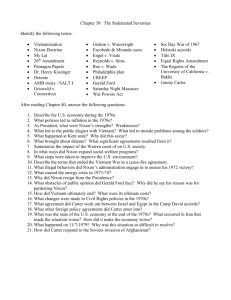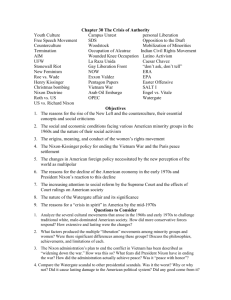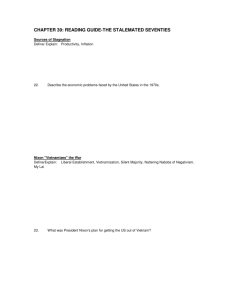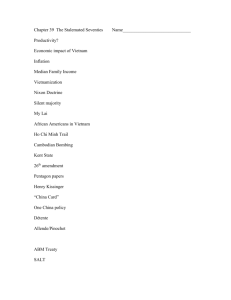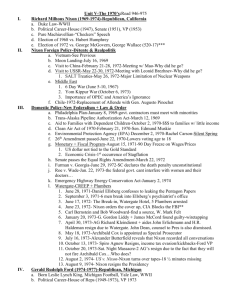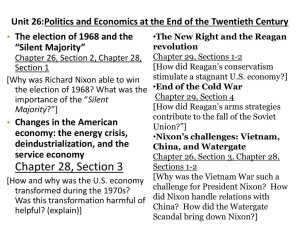Chapter 31 Outline - Continuing Divisions and New Limits, 1969–1980
advertisement
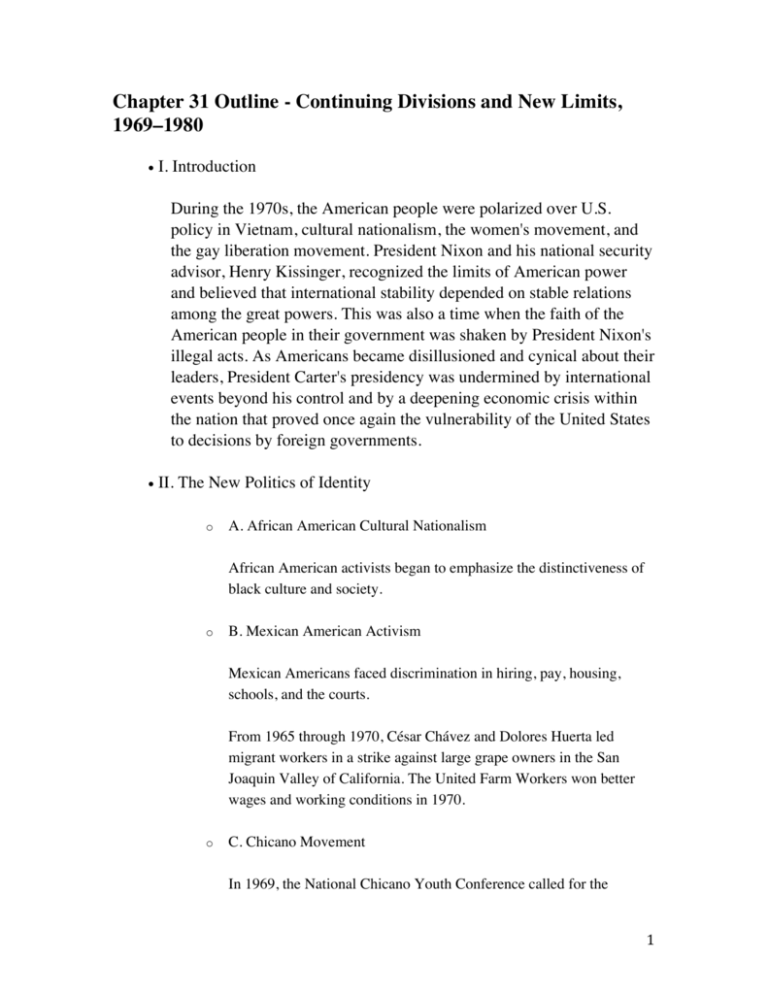
Chapter 31 Outline - Continuing Divisions and New Limits, 1969–1980 • I. Introduction During the 1970s, the American people were polarized over U.S. policy in Vietnam, cultural nationalism, the women's movement, and the gay liberation movement. President Nixon and his national security advisor, Henry Kissinger, recognized the limits of American power and believed that international stability depended on stable relations among the great powers. This was also a time when the faith of the American people in their government was shaken by President Nixon's illegal acts. As Americans became disillusioned and cynical about their leaders, President Carter's presidency was undermined by international events beyond his control and by a deepening economic crisis within the nation that proved once again the vulnerability of the United States to decisions by foreign governments. • II. The New Politics of Identity o A. African American Cultural Nationalism African American activists began to emphasize the distinctiveness of black culture and society. o B. Mexican American Activism Mexican Americans faced discrimination in hiring, pay, housing, schools, and the courts. From 1965 through 1970, César Chávez and Dolores Huerta led migrant workers in a strike against large grape owners in the San Joaquin Valley of California. The United Farm Workers won better wages and working conditions in 1970. o C. Chicano Movement In 1969, the National Chicano Youth Conference called for the 1 liberation of "La Raza" (the brown people) from the oppression of American society and culture. Throughout the 1970s, young activists called for "Brown Power" based on a separate and distinct Chicano culture. o D. Native American Activism Young Native Americans were influenced by cultural nationalist beliefs, and between 1968 and 1975, Native American activists forced American society to hear their demands and to reform government policies toward Native Americans. In 1969, a group of activists occupied Alcatraz Island and demanded the return of the land to native peoples for use as a cultural center. In 1972, members of the American Indian Movement occupied a Bureau of Indian Affairs office in Washington, D.C. In 1973, members of AIM occupied a trading post at Wounded Knee, South Dakota. In response to the demands of these radical activists and to the work of more moderate Native Americans, Congress in 1975 passed the Indian Self-Determination and Education Assistance Act. o E. Affirmative Action President Johnson indicated his belief that the federal government had a responsibility to helpindividuals attain the skills necessary to compete in American society. He wedded this belief to the idea that equality could be measured by group outcomes. This led to a shift in emphasis from individual opportunity to group outcomes. The Philadelphia Plan, implemented by President Nixon in 1969, was the first major government affirmative-action program. 2 • III. The Women's Movement and Gay Liberation o A. Liberal and Radical Feminism The need for action in advancing women’s issues led the liberal wing of the women’s movement to found the National Organization for Women (NOW) in 1966. A more radical brand of feminism emerged in the late 1960s. Although radical feminists differed with one another in some of their beliefs, they generally preferred confrontational, direct action and believed in “personal politics.” o B. Accomplishments of the Women’s Movement Congress approved the Equal Rights Amendment in 1972. Congress also passed Title IX of the Higher Education Act in 1972. Women were successful in establishing rape crisis centers in many communities by the end of the 1970s. In 1973, citing a woman’s constitutional right to privacy, the Supreme Court legalized abortions. By the late 1970s, female participation in professional schools had climbed to record highs. o C. Opposition to the Women’s Movement Organized opposition to the women’s movement had a primarily conservative and religious orientation. Opponents such as Phyllis Schlafly took a “profamily” stance and blamed feminism and the women’s movement for many of America’s social problems. In the STOP-ERA campaign, Schlafly and others used fear tactics in a successful attempt to prevent ratification of the Equal Rights 3 Amendment. o D. Gay Liberation Many homosexuals became more open, and a 1969 riot in Greenwich Village marked the genesis of “Gay Power.” Gay and lesbian activists focused on legal equality and Gay Pride. o IV. The End in Vietnam o A. Invasion of Cambodia The policy of “Vietnamization” (replacing Americans with South Vietnamese troops) was central to Nixon’s policy in Vietnam. As Nixon began to withdraw American troops in the late 1960s and early 1970s, he intensified the bombing of North Vietnam and began a secret bombing campaign in neutral Cambodia. In 1970, Nixon announced that American and South Vietnamese forces had entered Cambodia. o B. Protests and Counterdemonstrations The announcement of the invasion of Cambodia sparked violent protests in the United States, most notably at Kent State University in Ohio and at Jackson State in Mississippi. Congress responded to the invasion of Cambodia by terminating the Tonkin Gulf Resolution. Construction workers in New York City organized counterdemonstrations against antiwar protests. The New York Times began publication of the Pentagon Papers in June 1971. The American public learned that their leaders had consistently 4 lied to them about American aims and strategies in Vietnam. o C. Morale Problems in the Military There were growing reports of morale and discipline problems among the troops in Vietnam. It was learned that in 1968 a gruesome atrocity occurred at the village of My Lai, where Americans killed some 500 unarmed civilians. o D. Paris Peace Accords In 1973, America and North Vietnam agreed to withdraw American troops, return POWs, account for MIAs, and recognize a role for the Vietcong in South Vietnam. On April 29, 1975, after American troops had been withdrawn from Vietnam, the South Vietnamese government collapsed. Vietnam was reunified under a communist government based in Hanoi. o E. Costs of the Vietnam War More than 58,000 Americans and 1.5 to 3 million Vietnamese died in the war. The conflict cost the United States at least $170 billion, caused inflation and a retreat from reform within the United States, and it delayed improved relations with other nations. o F. Debate over the Lessons of Vietnam Hawks claimed the war undermined America’s credibility; Doves insisted that losing the war showed the dangers of an imperial presidency. Congress passed the War Powers Act of 1973. o G. Vietnam Veterans Post-traumatic stress disorder plagued thousands of veterans, causing 5 them fears and anxiety. • V. Nixon, Kissinger, and the World o A. Nixon Doctrine In an admission of the limits of American power and resources, Richard Nixon announced that the United States would provide economic aid to nations in Asia and elsewhere, but they could no longer count on American troops. o B. Détente Richard Nixon and Henry Kissinger sought détente that would recognize Soviet-American rivalry while creating cooperation through negotiations. In May 1972, the United States and the USSR agreed to limit the construction and deployment of intercontinental ballistic missiles and antiballistic missile defenses. o C. Opening to China Nixon extended détente to the People’s Republic of China, and he made a historic trip there in 1972. o D. Wars in the Middle East When Egypt and Syria attacked Israel in 1973, OPEC stopped oil shipments in an effort to gain American support for the Arabs. In 1975, Kissinger persuaded Egypt and Israel to accept a U.N. peacekeeping force in the Sinai. o E. Antiradicalism in Latin America and Africa Nixon plotted covert actions against Salvador Allende, while continuing to deny it. 6 Nixon viewed the white minority governments in Rhodesia and South Africa as bulwarks against communist-inspired radicalism. • VI. Presidential Politics and the Crisis of Leadership o A. Nixon’s Domestic Agenda Nixon’s presidency was driven by his hatred of the “liberal establishment.” Nixon’s domestic policies are confusing to many historians. In some respects his policy initiatives seem “liberal,” but in other ways he pursued a conservative agenda. Most of Nixon’s “liberal” agendas were in fact attempts to undermine liberal programs while seeming to offer support. In an effort to attract white southerners to the Republican Party, Nixon pursued a “southern strategy” by attempting to appoint two southern justices to the Supreme Court and by denouncing the use of busing to achieve racial integration in the North Carolina school system. o B. Enemies and Dirty Tricks On June 17, 1972, five men associated with the Committee to Re-elect the President were arrested for breaking into the Democratic National Committee’s offices at the Watergate apartment complex. Nixon was obsessed with the idea that he was surrounded by enemies. He authorized the formation of a secret group known as the Plumbers, which engaged in break-ins and political dirty tricks. o C. Watergate Cover-Up and Investigation The White House began feverish efforts to destroy any link with the men arrested in the Watergate break-in. 7 Woodward and Bernstein with the Washington Post began, with the aid of an anonymous source known as Deep Throat, now known to be W. Mark Felt, to follow a money trail that led to the White House. Judicial and Congressional investigations uncovered misconduct high in the Nixon administration. o D. Impeachment and Resignation In July 1974, the Supreme Court ruled that Nixon had to turn over all the Oval Office tapes to Congress. Facing the prospect of impeachment and conviction on three counts, Nixon resigned as president on August 9, 1974. The excesses of Nixon’s term led Congress to pass laws restraining presidents in foreign affairs, preventing the impounding of federal appropriations, limiting campaign funding, and ensuring access to government documents. o E. Ford’s Presidency Throughout his term, very little was accomplished. Ford discovered that as a result of the Watergate scandal the way in which the press covered the office of the presidency had changed. o F. Carter as “Outsider” President Jimmy Carter took advantage of the reaction against Watergate to defeat Gerald Ford in 1976. Carter refused to acquiesce to the deal-making that was necessary to pass legislation in Congress. Carter, willing to tell the American people the hard truths, spoke to them about the new era of limits. 8 Carter worked to ease burdensome government regulations, created the Departments of Energy and Education, created the environmental “superfund” to clean up chemical-waste sites, and placed more than 100 million acres of Alaskan land under the protection of the federal government. • VII. Economic Crisis o A. Stagflation and Its Causes During the 1970s, the economy was plagued with high unemployment and an inflationary spiral. Stagflation was caused by a variety of factors such as Johnson’s spending on the Vietnam War while also expanding domestic spending, the U.S. trade deficit, a decline in productivity, and a decline in the quality of American goods. One of the most important reasons for the economic problems of the 1970s was the energy crisis that began in 1973. When the OPEC oil embargo caused a 350 percent increase in oil prices, the increases had a ripple effect throughout the entire economy. o B. Attempts to Fix the Economy Attempts by American leaders to deal with the nation’s economic problems often exacerbated those problems. o C. Impacts of the Economic Crisis The economic crisis accelerated the transition from an industrial economy to a service economy. The economic crisis helped shift the nation’s economic and population centers to the Sunbelt. 9 o D. Tax Revolts A tax revolt began in the American West, with California’s Proposition 13 being an example. The tax revolt movement signaled the birth of a new conservatism. o E. Credit and Investment In an era of double-digit inflation, thriftiness no longer made sense. As a result, consumer debt rose significantly. Money flowed out of passbook savings accounts into money market investments and into the stock market. • VIII. An Era of Cultural Transformation o A. Environmentalism Several ecological crises reminded Americans of the limits on the world’s natural resources and of the fragile nature of the environment. Public activism led to major environmental regulations and initiatives. o B. Technology Technological advances that put a man on the moon seemed unable to deal with the worldwide problems of poverty, crime, pollution, and urban decay. During the 1970s, the foundation was laid for America’s computer revolution. o C. Religion and the Therapeutic Culture Many Americans turned to evangelical and fundamentalist Christian churches to find spiritual fulfillment. Other Americans turned to the “New Age” movement. 10 Americans turned to self-fulfillment through the “therapeutic culture” that emerged through the publication of self-help books in the 1970s. o D. Sexuality and the Family Sex became a more visible part of America’s public culture during the 1970s. Sexual behaviors changed during the 1970s, and there was more acceptance of premarital sex and of homosexuality. Changing sexual mores also changed the American family. o E. Youth New freedoms and responsibilities existed for America’s youth by the 1970s. Eighteen-year-olds were given a constitutional right to vote and in many states the privilege to drink alcohol legally. Drug use increased as many youths adopted a preference for communal living seeking a “counterculture” outside mainstream America. o F. Diversity Americans became more aware of the differences among the nation’s peoples. Some began to view diversity in American society as a strength rather than a weakness. The Supreme Court ruled in Regents of the University of California v. Bakke that race could be taken into account to achieve diversity in educational institutions. 11 • IX. Renewed Cold War and Middle East Crisis o A. Carter’s Divided Administration Jimmy Carter suffered from indecision and from squabbles among members of his administration, hampering his attempts to put the nation’s fear of communism in the past. Carter signed treaties with Panama that turned the Canal Zone over to Panama in the year 2000 and allowed the United States to defend the Canal Zone after that time. o B. Camp David Accords Jimmy Carter helped ease tensions in the Middle East by negotiating an accord between Egypt and Israel. o C. Soviet Invasion of Afghanistan When the Soviets invaded Afghanistan in December 1979, Carter suspended shipments of grain and high-technology equipment to the Soviet Union, withdrew an arms control treaty from Senate consideration, and initiated a boycott of the 1980 Summer Olympics. The Carter Doctrine warned that the United States would intervene if Soviet aggression threatened the Persian Gulf. o D. Iranian Hostage Crisis In 1979, Iranians stormed the U.S. embassy in Teheran and took a number of hostages. The United States unfroze Iranian assets and promised no further intervention in Iran in January 1981, and the hostages were released. o E. Rise of Saddam Hussein Although officially neutral, the United States tilted toward Iraq in its 1980 war with Iran. 12 Although Carter was inconsistent in his application of the humanrights test, he popularized and institutionalized the concern for human rights throughout the world. 13
